Physical Address
304 North Cardinal St.
Dorchester Center, MA 02124
This chapter includes an accompanying lecture presentation that has been prepared by the authors: ![]() .
.
This chapter includes an accompanying lecture presentation that has been prepared by the authors: ![]() .
.
The blood-brain barrier (BBB) is a neurovascular unit that consists of microvascular endothelium, neurons, basement membrane, and neuroglial structures, including astrocytes, pericytes, and microglia.
The main role of the BBB is to serve as both a physical and an enzymatic barrier, which regulates transport between the central nervous system (CNS) and the periphery.
Permeability of the BBB is mediated by four fundamental transport mechanisms: (1) paracellular aqueous diffusion, (2) transcellular lipophilic diffusion, (3) adsorptive transcytosis, and (4) saturable transport.
Pathologic conditions alter the mechanisms that regulate BBB permeability, resulting in increased vascular permeability and subsequent edema formation. These conditions include trauma, inflammatory and autoimmune disease, infection, cerebrovascular and neurodegenerative disease, epilepsy, and brain tumors.
In order to develop effective therapy for CNS disease, drug agents need to penetrate the brain by crossing the BBB via one of its transport mechanisms or by altering the permeability of the BBB.
The blood-brain barrier (BBB) is a “neurovascular unit” composed of microvascular endothelium, basement membrane, neurons, and neuroglial structures: astrocytes, pericytes, and microglia. The BBB is a dynamic gatekeeper that anatomically connects and interacts with peripheral intravascular signals, cerebrospinal fluid (CSF), and the parenchymal environment to mediate a complex system of exchange, transport, and clearance. Perturbation of BBB integrity has been implicated in a wide variety of human brain pathologies, and it has become clear that despite its location at the blood-brain interface, the potential impact of the BBB is more widespread and complex than initially believed. For example, the pathogenesis of multiple sclerosis (MS) is dependent on extravasation of leukocytes through the BBB and into the parenchyma, and therapeutics targeted at increasing BBB integrity, such as interferon-β, have been relatively effective in reducing the rate of relapse. Ischemic stroke, originally viewed as inducing some short-term mechanical disruption of the BBB, has been shown to lead to chronic inflammation and thus increased BBB permeability, potentially contributing to long-term detrimental sequelae. Therefore treatments are now being identified and studied to target maintaining integrity at the BBB when disruption may worsen disease pathogenesis.
The BBB is an active and dynamic organ that ensures adequate concentration of essential compounds such as oxygen and glucose and at the same time protects the brain from deleterious substances in the peripheral circulation. The BBB selectively prevents passage of substances into the brain via tight junctions (TJs) or enzymatic reactions while selectively carrying small and large molecules by passive and facilitated diffusion and active transport. Clearance through the perivascular spaces governs the contents of the intraparenchymal space in conjunction with the BBB. A pathway long ago described, but only recently brought to the forefront of scientific discussion, the exchange of fluid and solute between the parenchyma and vasculature has been termed the glymphatic system. Building upon the traditional view of unidirectional ventricular CSF flow, the BBB appears to mediate a balance of hydrostatic and osmotic forces that generates a continuous influx and clearance throughout the brain.
The synergistic integration of all molecular and structural components gives rise to this functional complex called the BBB. Disruption of the BBB is seen in numerous pathologic processes. The discriminatory nature of the neurovascular unit prevents the delivery of many therapies to the brain, including certain chemotherapeutic agents, antiviral drugs, or neuromodulators. Novel methods of circumventing the BBB via osmotic disruption, targeting of junctional proteins, or co-opting facilitated transport mechanisms may provide novel therapies to treat a variety of neurological disorders. Scientific investigation of the BBB continues to provide insight into this complex and dynamic system and may generate much needed therapies to treat numerous neurological diseases.
The BBB consists of astrocytes, pericytes, microglia, neurons, and the extracellular matrix (ECM), all of which play a supportive role in maintaining integrity of this structure. , The concept of the neurovascular unit has recently been married to the BBB concept to illustrate the fact that an intimate contact exists between BBB cells (endothelial cells and perivascular glia) and the brain parenchyma (principal neurons, interneurons, microglia, oligodendroglia, and astroglia). More recently, it has become clear that cells involved in the production and reabsorption of CSF also need to be considered as members of the neurovascular unit. This is discussed in more detail later.
This deceptively simple anatomic structure conceals a complex, multifaceted network of pathways and interactions that create a far more dynamic unit than the usual barrier function descriptor implies. Increasing characterization of BBB structure and function has been facilitated by the identification of BBB pathology in neurological disorders such as stroke, epilepsy, and neuroinflammation, among others. The anatomic BBB is formed by a monolayer of microvascular endothelial cells (ECs) that line the intraluminal space of brain capillaries and are supported by astrocyte end-feet. The low permeability that characterizes the BBB is conferred in part by tight packing of ECs and formation of TJs and adherens junctions (AJs). The EC layer has a luminal (inside the brain) and abluminal (outside the brain) membrane separated by 300 to 500 nm of cytoplasm between the blood and brain. The luminal surface is in contact with the blood supply, whereas on the abluminal surface, ECs are enveloped in a basement membrane and separated into regions associated with a pericyte. Neighboring cells are connected by TJs and AJs. TJs regulate paracellular transport and consist of occludin, claudin, and junctional adhesion molecules. AJs mediate cell spacing and transmit cytoskeletal signals and include cadherin, catenins, vinculin, and actinin ( Fig. 68.1 ).
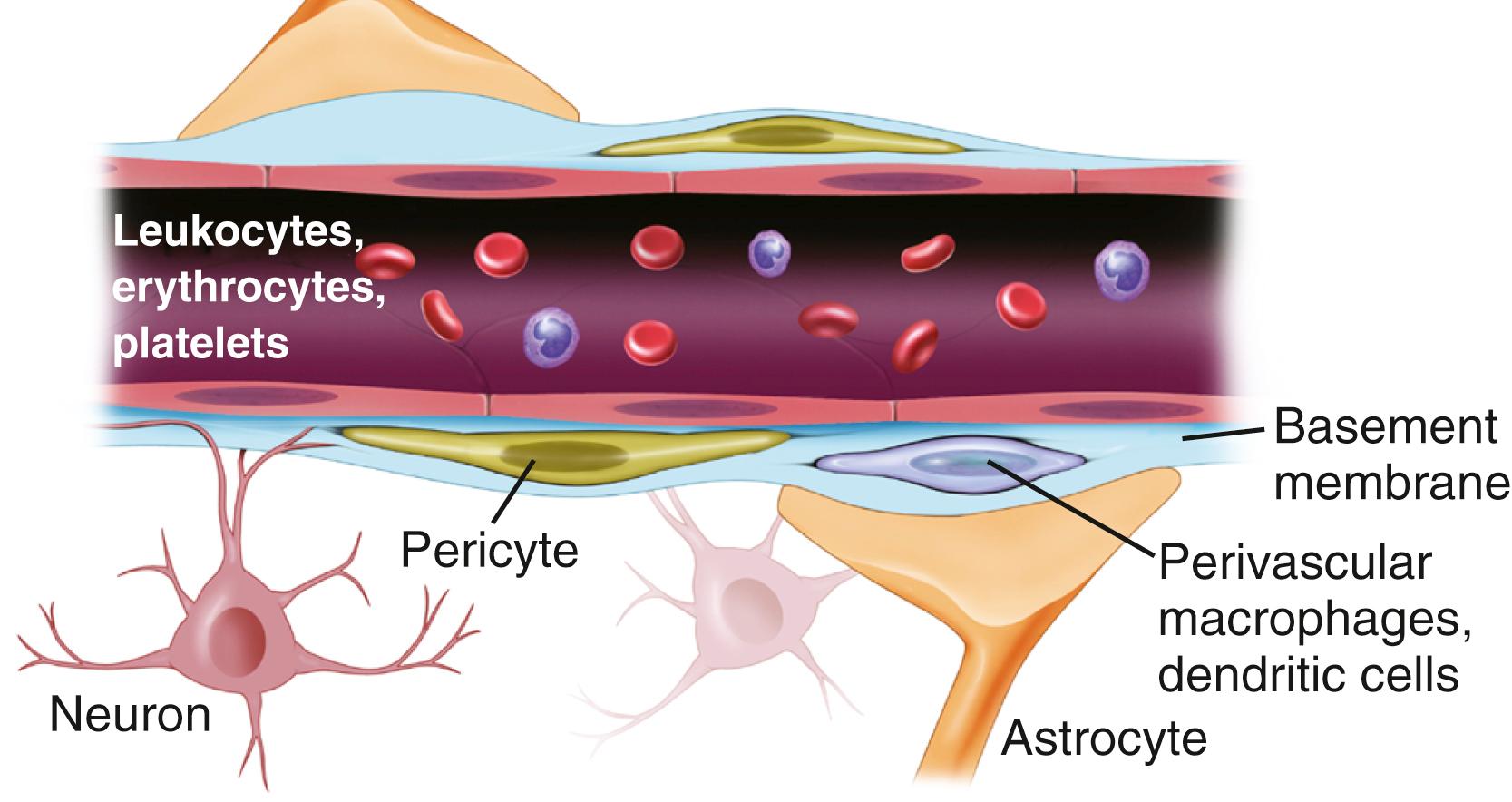
There are two fundamental morphologic characteristics that differentiate brain ECs from peripheral ECs. The cytoplasm of brain microvascular ECs has rare pinocyte vesicles—fluid-filled cell membrane invaginations that allow compounds to cross the BBB. These ECs also contain a greater concentration of mitochondria, presumably to generate the greater energy needed to actively transport nutrients.
In addition to the structural integrity of the BBB, there is an enzymatic surveillance system that metabolizes drugs and other compounds that manage to bypass the structural barrier. Three main catalytic agents regulate transportation across the BBB: γ-glutamyl transpeptidase, alkaline phosphatase, and aromatic l -amino acid decarboxylase. These are concentrated in cerebral vessels. The role of cytochrome P-450 (CYP) enzymes at the BBB has taken on a greater significance in local drug metabolism. Heterogeneity in the activity and expression of these enzymes may impact variability in drug response or have other pathologic implications ( Box 68.1 ).
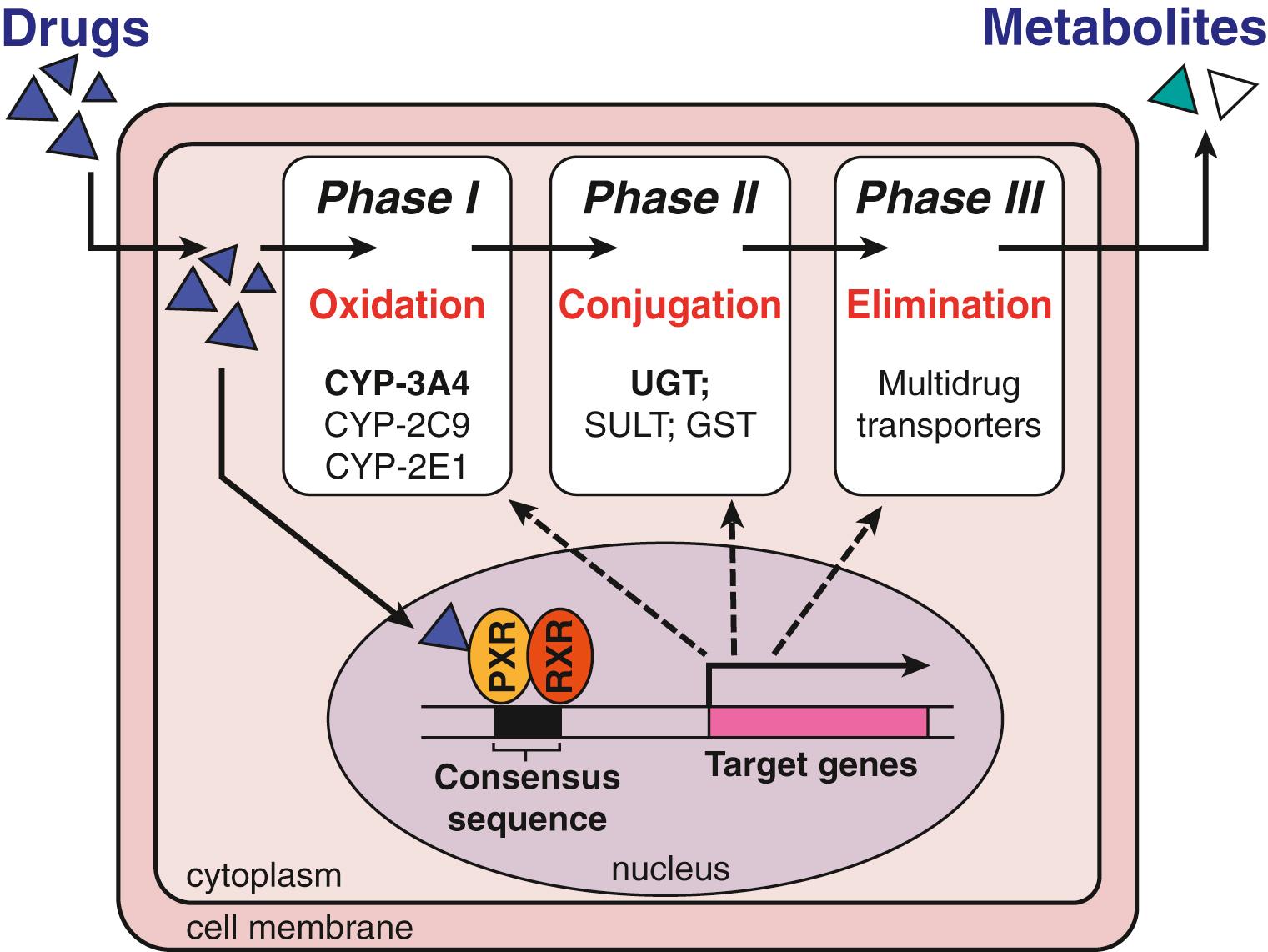
Cytochrome P-450 (CYP) enzymes are essential for the metabolism of many drugs. Although this molecular family comprises more than 50 enzymes, a handful of CYP enzymes are responsible for the metabolism of 90% of drugs. These include CYP3A4, CYP2D6, CYP2E1, CYP2C9, and CYP2C19. CYPs are abundant in the liver, but appreciable amounts are also expressed in many extrahepatic tissues, including the brain. Although the total amount of CYP is less in the brain than in the liver, the localized expression of these drug-metabolizing enzymes at the blood-brain barrier and the neurovascular unit provides a potent mechanism of biotransformation in proximity to neurons. , , CYP enzymes catalyze the formation of neurosteroids and eicosanoids, and metabolize substrates as diverse as vitamins A and D, centrally acting drugs, anesthetics, and environmental neurotoxins. These unique characteristics allow this family of proteins to control vital functions such as neurotrophic support, neuroprotection, control of cerebral blood flow, and maintenance of brain cholesterol homeostasis.
CYP enzymes can be inhibited or induced by drugs, causing clinically significant drug-drug interactions leading to unanticipated adverse reactions or unexpected therapeutic benefits. Thereby, changes in the function of brain CYP metabolism can influence drug response, drug toxicity, and drug-induced behavioral changes. As an example, metabolism of drugs by CYP enzymes causes biotransformation of an antiepileptic drug, carbamazepine, into a proconvulsant toxic metabolite. Finally, central nervous system drug metabolism may contribute to interindividual variation in response because brain CYP enzymes have unique regional induction patterns that are regulated independently of their hepatic isoforms. Understanding these different aspects of CYP enzymes in brain function and physiology is essential for improved future drug therapy and reduced neurotoxic side effects.
There is charge polarity between the abluminal and luminal surfaces of ECs. This polarity influences permeability of the barrier and is regulated in part by TJs. Differential receptor expression and density on the luminal versus abluminal surfaces allow for directional transport of solutes such as glucose and ions such as sodium, potassium, and calcium. EC polarity plays a significant role in generating interstitial fluid and maintaining homeostatic gradients within the interstitial fluid. Perturbation of transporter activity has been implicated as a potential cause of edema following ischemic stroke. Differential expression of luminal versus abluminal ion transporters is still being characterized; however, transporters such as Na + ,K + -ATPase, the Na + /H + exchange transporter, and the Na + amino acid transporter are found predominantly on the abluminal membrane. Other shuttling proteins that contribute to transport polarity include glucose transporter protein 1 (GLUT1), which is concentrated at the abluminal membrane, and drug efflux pumps, which are differentially distributed between luminal and abluminal membranes. P-glycoprotein (aka multidrug resistance protein 1 [MDR1]), which is the product of the human multidrug resistance 1 gene ( MDR1 ), is concentrated at the luminal membrane. Enzyme polarity is also present, with examples including alkaline phosphatase and γ-glutamyl transpeptidase, which are concentrated in the luminal compartment. Redistribution of multidrug resistance transporters occurs during pathologic events involving BBB breakdown, presumably to enhance clearance of toxins, and is relevant for delivery of drugs to the central nervous system (CNS). BBB polarity is additionally maintained by astrocytes, in which distribution of aquaporin-4 plays a significant role in water absorption and potentially in edema formation.
The neurovascular unit is made up of several key cell types in addition to the brain ECs, which include astrocytes, pericytes, neurons, and microglia. Astrocytes reinforce barrier function and contact ECs on the abluminal side of the BBB endothelium. Astrocytes have end-feet that border the basement membrane of parenchymal vessels and densely surround TJs, reducing the size of the gap between ECs. More than 90% of astrocyte foot processes surround ECs. They are associated with adrenergic and cholinergic nerve terminals, as well as those that respond to peptides ( Fig. 68.2 ).
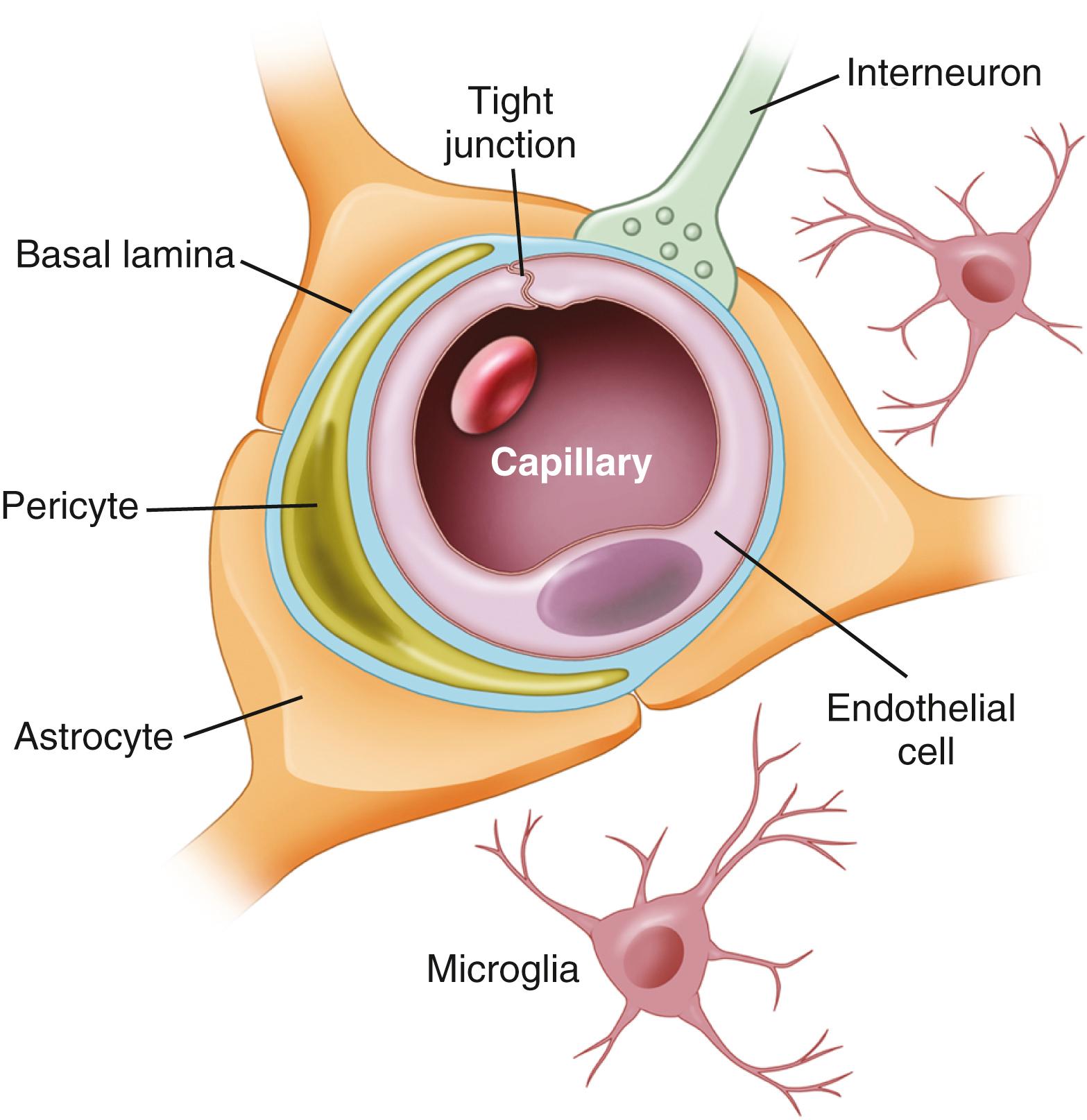
Astrocytes appear to be critical in regulating BBB permeability, and the majority of in vitro experiments have demonstrated BBB compromise in their absence. , Several studies, however, have indicated that BBB integrity is retained amid degradation of astrocytes, thus suggesting that astrocytes regulate BBB activity indirectly rather than through physical interaction. Astrocytes are able to induce both the barrier and permeability properties of the endothelium. This was first demonstrated in 1981 by Stewart and Wiley, who found that newly formed vessels originating from the coelomic cavity display BBB characteristics when placed in contact with grafts of neural tissue. Later, Janzer and Raff demonstrated that astrocytic aggregates induced a functional BBB in nonbrain ECs of the anterior chamber of the eye. Astrocyte media can also be used to induce BBB-like properties in ECs in vitro. Thus the mechanism of astrocyte-mediated induction, maintenance, and obliteration of the BBB is only partially understood. To address this issue, researchers have described a “BBB transcriptome” as a means to better understand the complexity and dynamic changes that occur at the brain-blood interface.
Efforts to develop a microfluidic model of the BBB—a “BBB on a chip”—have attempted to recapitulate barrier function by incorporating sheers stress into a variety of culture systems, for example, EC-astrocyte co-culture with cell types separated by a porous membrane ( Box 68.2 ). Models incorporating fluid flow and shear stress have achieved higher transendothelial electrical resistance than static models, suggesting more effective barrier function. These systems have been used to test drug permeability and may eventually be effective tools to study pharmaceutical approaches to modulating BBB integrity.
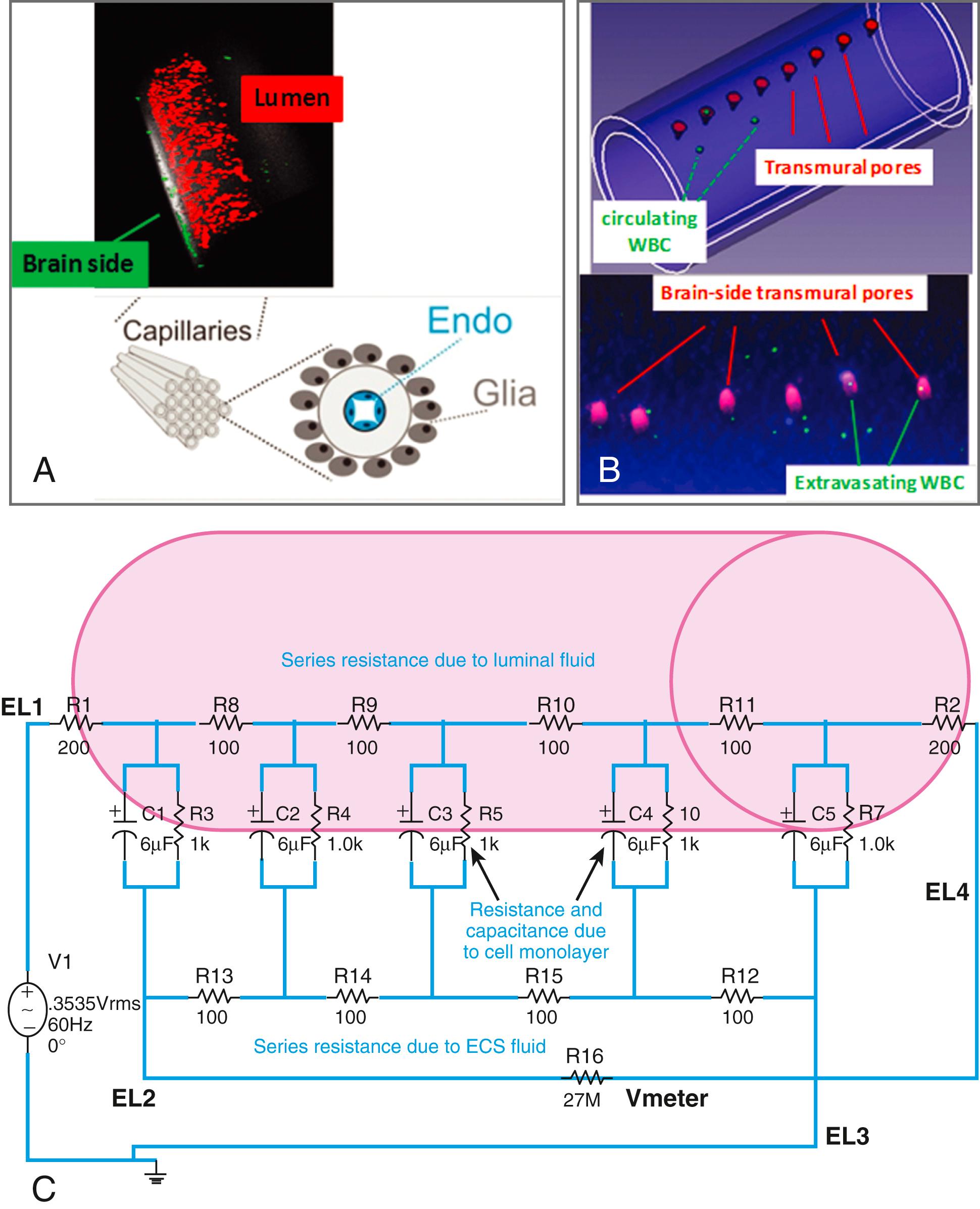
As the blood-brain barrier (BBB) rises to prominence in a wide variety of neurological research studies, efforts to model both the intact and dysfunctional BBB have led to development of many animal and in vitro models. Efficient and accurate BBB modeling would be a significant step forward in drug screening for compounds able to permeate the BBB as well as in investigation of BBB dysfunction in pathologic conditions such as multiple sclerosis, stroke, and epilepsy.
In vivo modeling of the BBB has utilized rat and murine transgenics to assess the importance of various BBB components and signaling pathways to barrier function and integrity. Transgenic models, particularly knockouts, have been used to characterize the role of efflux and influx transporters (e.g., ATP-binding cassette and glucose transporter protein 1), aquaporin-4, matrix metalloproteinases, calveolin, and angiogenic factors such as vascular endothelial growth factor in BBB function. Other models have assessed the role of pericytes, tight junction proteins, integrins, selectins, , and chemokines in BBB integrity and leukocyte extravasation. , One novel model to investigate BBB permeability during development and selected interventions utilized a zebrafish with a blood-borne endogenous fluorescent tracer.
In vitro models have emphasized the use of endothelial cell–astrocyte co-cultures, or more recently tricultures with pericytes and have primarily utilized porcine, rat, murine, and bovine cells. The role of astrocytes in conferring BBB properties on endothelial cells in conjunction with the importance of flow and shear stress in BBB function has clearly demonstrated the need for integrated modeling systems incorporating these components. Microfluidic systems have allowed for the development of compact BBB models that include fluid flow. These systems have the potential for facilitating high-throughput screening of central nervous system–targeted drugs. However, significant characterization of transendothelial electrical resistance measurement, permeability, and other parameters is required to determine the validity of each model. The fundamental role of intraluminal shear stress has been emphasized, and recent modeling efforts have shown that BBB function is modulated by shearing forces acting on the endothelial membrane. , Models have also been developed to allow for leukocyte adhesion studies under flow or altered flow conditions.
With increasing improvements in protocols for differentiation of induced pluripotent stem cells (iPSCs), BBB models using human iPSCs may hold promise for the future. This approach would not only address the challenges of using nonhuman cells to model the human BBB, but would also open up new avenues for research addressing the genetic components of diseases such as multiple sclerosis or drug-resistant epilepsy. However, widespread application of this method will require further improvement in differentiation protocols and further characterization of the resulting cells.
Pericytes are undifferentiated contractile connective tissue cells that localize to capillary walls, aid in regulating the growth of ECs, and modulate the integrity of capillary cells. They share a common basement membrane with brain ECs and act as a secondary BBB in a manner similar to macrophages by monitoring the perivascular space and phagocytosing unwanted substances. Although pericytes lack contractile actin, they have been implicated in regulation of cerebral blood flow (CBF) and in pathologic states such as the no-reflow phenomenon of impaired blood flow following an ischemic stroke.
In vitro studies have demonstrated communication between ECs and pericytes. The proposed mechanism of this communication is via cellular projections, which penetrate the basal lamina and cover 20% to 30% of the microvascular circumference. Pericytes are most abundant on venules, where they provide mechanical support and synthesize ECM proteins such as laminin and fibronectin. Platelet-derived growth factor receptor (PDGFR) is a tyrosine kinase receptor expressed on the surface of pericytes that was targeted for the treatment of malignant brain tumors. Clinical trials were conducted with imatinib, a PDGFR inhibitor, on patients with glioblastoma multiforme (GBM) who were refractory to chemotherapy and radiation therapy. However, while initially promising in early phase 1 and 2 trials, later phase 2 and 3 trials failed to demonstrate superior efficacy compared to standard therapy. Pericytes migrate away from the site of injury in pathologic conditions that increase BBB permeability, such as trauma or seizures. Increasing recognition of the role of pericytes in homeostatic regulation at the BBB should prompt investigation into pericytes as possible therapeutic targets, particularly in seizures.
Neurons are the building blocks of the CNS. The role of neuronal modulation at the BBB is primarily enzymatic ( Table 68.1 ). Dynamic brain imaging studies, such as positron emission tomography (PET) and functional magnetic resonance imaging (MRI), detect regional increases in CBF and glucose and oxygen consumption, which are associated with local increases in neuronal activity. Neurons upregulate catalytic factors specific to ECs and provide noradrenergic, serotoninergic, cholinergic, and GABAergic (transmitting or secreting γ-aminobutyric acid [GABA]) innervation to astrocytes and their associated ECs.
| Decreased Blood-Brain Barrier Permeability |
| Intracellular cyclic adenosine monophosphate (cAMP) |
| Steroids |
| Adrenomedullin |
| Noradrenaline |
| Glial cell line–derived neurotrophic factor (GDNF) |
| Basic fibroblast growth factor (bFGF) |
| Polyunsaturated fatty acids |
| Transforming growth factor-β (TGF-β) |
| Increased Blood-Brain Barrier Permeability |
| Bradykinin |
| Histamine |
| Serotonin (5-hydroxytryptamine [5-HT]) |
| Thrombin |
| Glutamate |
| Purine nucleotides: adenosine triphosphate (ATP), adenosine diphosphate (ADP), adenosine monophosphate (AMP) |
| Endothelin-1 |
| Adenosine |
| Platelet-activating factor |
| Phospholipase A 2 |
| Arachidonic acid |
| Prostaglandins |
| Leukotrienes |
| Interleukins: IL-1α, IL-1β, IL-6 |
| Tumor necrosis factor-α (TNF-α) |
| Macrophage inflammatory proteins: MIP-1 and MIP-2 |
| Complement-derived polypeptide: C3a-desArg |
| Free radicals |
| Nitric oxide |
Microglia are the resident macrophages of the CNS and provide immunosurveillance of the CNS and the perivascular space. They act as antigen-presenting cells, identifying, engulfing, and presenting foreign compounds that have “bypassed” the BBB to T cells. Microglia secrete proinflammatory cytokines and rapidly proliferate to contain offending agents. Microglia play important roles in the sequelae of stroke and trauma and are relevant in conditions characterized by pathologic inflammation, such as MS and, as shown more recently, other neurodegenerative diseases. Although microglial overactivity may reflect or promote harmful neuroinflammation, recently the role of microglia in clearance of debris has received significant attention regarding amyloid deposition in Alzheimer disease (AD). Documented microglial clearance of plaques suggests that in certain pathologic conditions, stimulation of microglial activity may be beneficial. , The ideal balance between the negative consequences of neuroinflammation and the positive role of inflammatory cells in clearance must be better defined in the context of individual neurological diseases.
The extracellular matrix provides physical stability to the BBB. It is a critical anchoring site that mediates polarity at the EC-astrocyte interface. Disruption of the ECM predictably impairs the structural integrity of the BBB, thus compromising its activity. Structural integrity of the BBB is maintained through interaction with several structural proteins, including laminin, collagen type IV, and integrins. Matrix proteins also upregulate TJ protein expression.
The permeability of the BBB to macromolecules is determined by both TJ-controlled paracellular permeability (through cell-cell junctions) and caveolae-mediated transcellular permeability. Caveolae are sites of endothelial transcytosis, endocytosis, and signal transduction. The relationship between paracellular and transcellular permeability is of crucial importance for the regulation of transendothelial permeability. Using electron microscopy, Majno and colleagues found that carbon particles injected into blood entered the parenchyma after brain tissue had been exposed to histamine, which promotes vasodilation. In addition, the authors reported gaps between ECs. Osmotic control of the BBB has been supported by electron microscopy studies, in which it was shown that the nuclei of ECs seemed to have a contracted, raisin-like appearance after exposure to histamine. This method of osmotic regulation of the BBB has since been further described. Clinical work has utilized this concept to induce osmotic disruption of the BBB and improve drug delivery to the CNS (see Table 68.1 ).
The precise vascular localization of the functional term blood-brain barrier might be extended beyond the capillary segments to CNS microvessels ( Fig. 68.3 ). The average total surface area of the brain microvasculature is 20 m 2 , whereas the surface area of cerebral capillary endothelium is 100 cm 2 /g tissue. The total length is 650 km, the inner capillary lumen is 6 μm, and in the cortex capillaries are 20 μm apart from one another. More than 99% of brain capillaries have a BBB, with the exception of the circumventricular organs. Circumventricular organs are important for peripheral chemosensing and include the median eminence, pituitary gland, choroid plexus, subfornical organ, lamina terminalis, and area postrema. Other nonstructural mechanisms of controlling traffic across the BBB include ion channels and transport carriers, which regulate influx and efflux of hydrophilic nutrients, metabolites, vitamins, hormones, and ions.
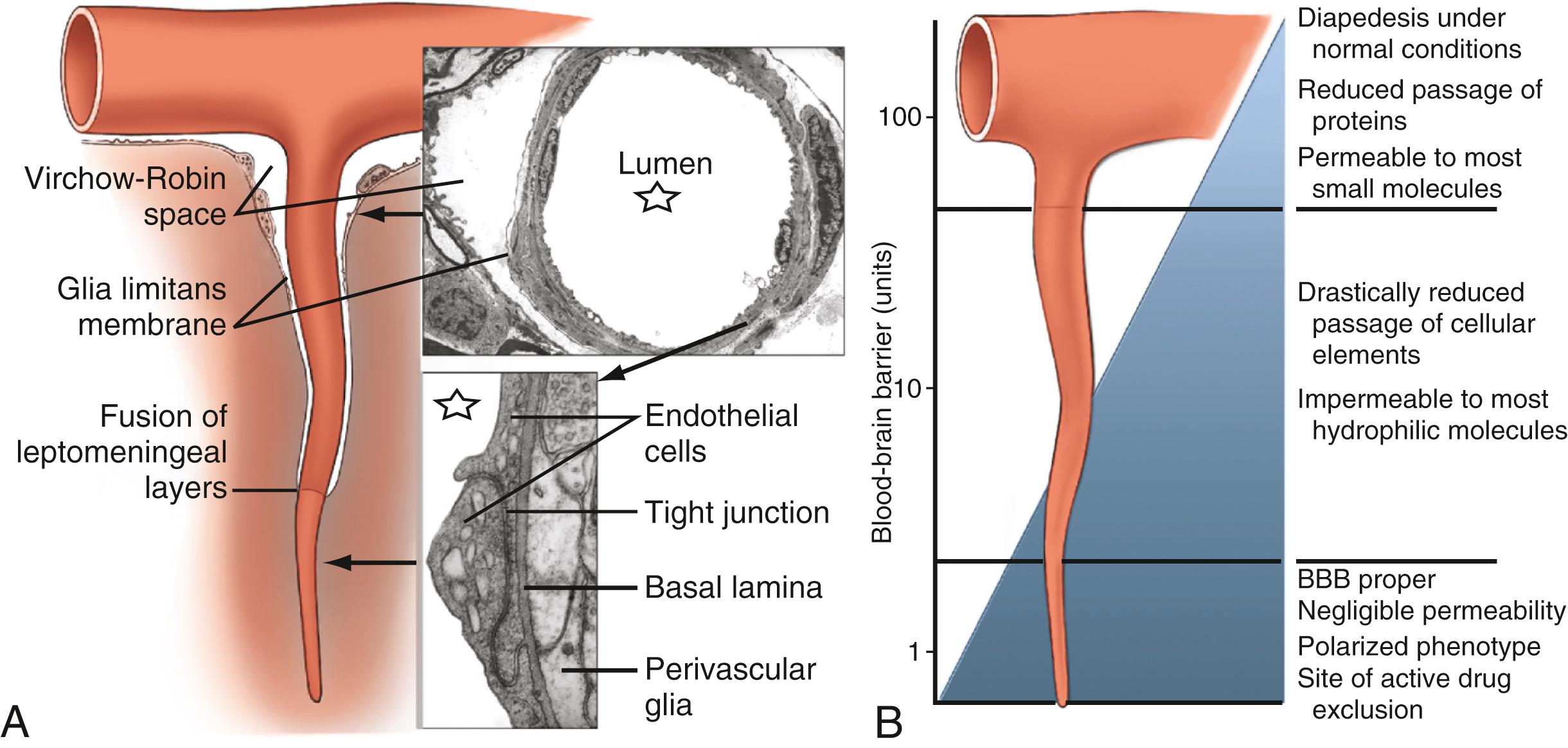
In summary, the brain microvascular endothelium differs from peripheral endothelium in three primary ways:
The BBB lacks fenestrations and is characterized by low pinocytotic activity, both of which markedly impair fluid uptake.
TJs are ubiquitous in brain ECs and impede paracellular transport of large or hydrophobic molecules across the BBB into the brain parenchyma.
Mitochondria are present at a much higher concentration, which provides the energy needed for active transport of various proteins and factors required by the brain.
Tight regulation of solute gradients and molecular transport is mediated by four primary transport mechanisms ( Fig. 68.4 ):
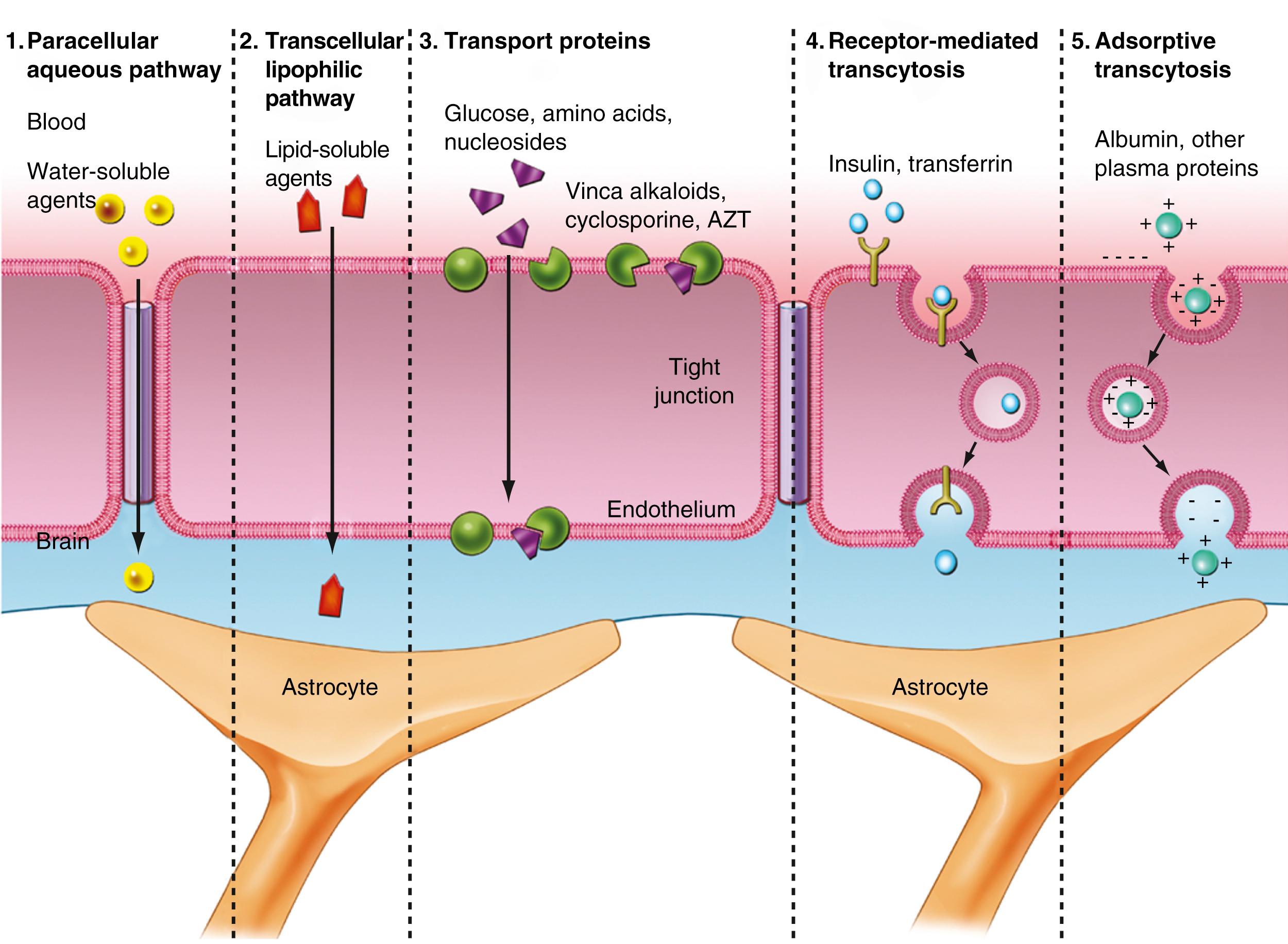
Paracellular aqueous diffusion—small water-soluble molecules are able to pass through this extracellular pathway, which is regulated by TJs.
Transcellular lipophilic diffusion—a transmembrane process by which substances cross the BBB at a rate proportional to their molecular weight and lipid solubility.
Adsorptive transcytosis—an endocytotic process mediated by clathrin-coated pits and, to a lesser extent, caveolae. It is generally selective for cationic molecules and is the predominant mechanism for passage of human immunodeficiency virus type 1 (HIV-1) into the brain. This process is being investigated as a possible pathway for therapeutic drug delivery to the CNS. ,
Saturable transport
Receptor-mediated transcytosis—transport of solutes via receptor binding and subsequent endocytosis. This can occur against a concentration gradient, but requires energy.
Channel-mediated transport—a saturable mode of transit that mediates influx and efflux via transport proteins.
BBB transporters ensure delivery of critical compounds that are essential for brain function. Several carrier systems exist at the BBB for transport of hexoses (glucose, galactose); neutral, basic, and acidic amino acids; monocarboxylic acids (lactate, pyruvate); purines (adenine, guanine); nucleosides (adenosine); amines; and ions. Uptake of larger molecules, including insulin and transferrin, occurs via receptor-mediated endocytosis.
GLUT1 is a 45- to 55-kD protein, depending on its glycosylation state. It is present in high concentration in the ECs of arterioles, venules, and capillaries and facilitates movement of d -glucose enantiomers from the peripheral circulation to the brain. The glucose transporter at the BBB is of particular importance because glucose is the primary source of energy for the brain and is required for normal brain activity and function. Transportation across the BBB occurs via a glucose transporter and is the rate-limiting step of primary energy acquisition. The rate of transport is proportional to CBF. There are five members of the sodium-independent glucose transporters in the brain, including GLUT1 (ECs), GLUT3 (neurons), and GLUT5 (microglia). Each can transport 2-deoxyglucose, 3- O -methylglucose, mannose, galactose, and glucose across the membrane. GLUT1 expression is three to four times higher on the abluminal membrane and is altered with processes such as hypoglycemia, diabetes, epilepsy, trauma, and tumors.
Delivery of neurotransmitters and amino acids across the BBB is achieved by carrier-mediated transport across the abluminal and luminal membranes in both a concentration-dependent and stereospecific manner. Factors affecting uptake of amino acids include their plasma-to-brain concentration, affinity of the transport system for a particular amino acid, and competition among amino acids for a particular transport system. Amino acid transport is classified into four systems. The first group is the large, neutral amino acid transporter (L type), which has a preference for leucine residues. These transporters are sodium independent, saturable, and stereospecific. The second group of transporters consists of small, neutral amino acids (A type). These transporters are dependent on sodium for movement across the BBB. Independent transporters for acidic and basic amino acids make up the third transport system. The rate of transfer of basic amino acids and large, neutral amino acids is high because of a high requirement for this subtype by the brain. Finally, alanine, serine, cysteine, and threonine residues use a sodium-dependent transport system that shuttles small, neutral amino acids across the BBB. Investigation of this transport system has suggested that its primary role is to transport amino acids out of the brain.
Glutamate is the most abundant amino acid in the CNS and is stored intracellularly against its concentration gradient. It is an excitatory neurotransmitter that, in addition to acting on postsynaptic receptors, serves a number of functions. It is involved in energy metabolism, molecular synthesis of glutathione and GABA, and breakdown and removal of ammonia. The maintenance of a very large gradient between extracellular fluid and intracellular glutamate is critical for normal neuronal signaling. Glutamate is synthesized from glutamine by neurons and is removed from the extracellular fluid by local astrocytes and by ECs at the BBB. To transport glutamate against its concentration gradient, ECs utilize a sodium-dependent mechanism of transport through the abluminal excitatory amino acid transporter. In addition to transport, the BBB also plays a role in glutamate metabolism.
In addition to glutamate, a number of other neurotransmitters cross the BBB, including aspartate, glycine, and GABA. In many instances, amino acid precursors cross the BBB before chemical modification into a functionally active protein. Such precursors include tryptophan, tyrosine, and histidine, which are modified to serotonin, dopamine and norepinephrine, and histamine, respectively. A classic example of the role of the BBB in neurotransmitter homeostasis is the transport of levodopa and subsequent dopamine synthesis. Levodopa is structurally similar to a neutral amino acid and enters ECs via a large, neutral amino acid carrier. ECs contain dopa decarboxylase, which converts levodopa to dopamine. The amount of dopamine generated in the brain is limited by EC expression of dopa decarboxylase. Other enzymes regulated by BBB metabolism include monoamine oxidase A and B, catechol O -methyltransferase, and pseudocholinesterase.
Adequate ion transport across the BBB is critical for brain function. Na + ,K + -ATPase is a well-established ion exchange protein on brain ECs that is found predominantly on the abluminal side. This channel protein controls K + levels by pumping Na + out of the cell and K + into the cell to preserve an electrochemical gradient across the membrane. In doing so, it facilitates sodium-dependent transport of other molecules and amino acids from the CNS extracellular fluid into ECs of the BBB.
Nitric oxide (NO) is well known for its properties as a vasodilatory agent, which also plays an important role in BBB regulation, immunomodulation, and autocrine activity. , It mediates the transport of ions and nutrients essential for brain function and is regulated by cyclic guanosine monophosphate and cyclic adenosine monophosphate.
Movement of ions across the BBB is also associated with the movement of water. Water traverses the plasma membranes via facilitated diffusion through water channels called aquaporins, by cotransport with organic or inorganic ions, and by diffusion across the lipid bilayer. The primary water channel in the CNS is aquaporin-4, which is predominately expressed by astrocytes. Immunolocalization studies with double staining for aquaporin-4 and glial fibrillary acidic protein, which stains astrocytes, show strong colocalization at the level of the BBB. , Involvement of aquaporin-4 in brain edema and water homeostasis has been well established. Iliff and colleagues have discovered additional roles of aquaporin-4 in waste clearance.
The mechanism underlying lipoprotein transport across the BBB has garnered considerable interest among researchers regarding potential exploitation for drug delivery. Low-density lipoprotein (LDL) receptors are expressed on the BBB, and LDL is transported across the BBB by endocytosis. The receptors responsible for LDL transport are currently being targeted for delivery of therapeutics conjugated to endogenous or engineered peptides and proteins that utilize these receptors to enter the CNS via the BBB. ,
Multidrug resistance proteins have also been intensely studied as a possible hindrance for drug delivery. MDR1 is an efflux transporter protein found in ECs, astrocytes, and microglia that is expressed on the luminal surface of the endothelial membrane and glia. MDR1 prevents toxins from entering the brain. Many drugs are substrates for MDR1, which limits their accumulation. Vinca alkaloids, anthracyclines, and taxanes are among the anticancer agents known to be transported by MDR1. Preclinical models have revealed that patients with deletion of MDR1 have 100-fold increased sensitivity to chemotherapy agents and antiviral compounds in comparison to control subjects. MDR1 is also protective in disease states such as AD, in which there is decreased deposition of β-amyloid (Aβ). However, overexpression of MDR1 is also found in patients with epilepsy, although it is unclear whether upregulation of the transporter is a pathologic process of epilepsy or secondary to resistance to antiepileptic drugs (AEDs). In vivo studies have shown depletion of MDR1 in patients with Parkinson disease.
Another important putative mechanism of drug resistance has emerged: expression of CYP enzymes in the brain. These are described in detail in Box 68.1 .
Early dogma claimed that leukocytes are rare within the brain due to the immune-privileged status maintained by the BBB. There is strong evidence that leukocytes traverse microvessels under inflammatory conditions via a paracellular route. , In addition, activated T lymphocytes maintain immunosurveillance of the CNS and can cross the endothelial wall with lower efficiency in the noninflammed state. Immunologic response to foreign pathogens, surveillance, and inflammation are regulated by leukocyte extravasation across the BBB. Extravasation occurs by means of integrins, intercellular adhesion molecules (ICAMs), and direct intercellular activity through a specific sequence of steps :
Capture and Rolling: mediated by binding between EC selectins and ligands on circulating cells.
Activation: involves chemokine signaling and consequent G protein–coupled receptor–mediated induction of integrin expression on the captured cell.
Arrest: increased expression of vascular cell adhesion molecules (VCAMs) and ICAMs on ECs, which bind T-cell integrins and arrest the cell on the endothelium.
Crawling: ICAM-mediated travel of the EC across the endothelium.
Extravasation: adhesion signals a conformational change in the actin cytoskeleton, which creates a window in the BBB for extravasation of cells in a transcellular or paracellular manner.
In addition, leukocytes secrete matrix metalloproteinases (MMPs), which degrade the ECM and facilitate subsequent passage of other molecules or leukocytes. These processes are pathologically upregulated in inflammatory disorders such as MS. In HIV encephalitis, actin cytoskeletal proteins such as Rho guanosine triphosphatase (GTPase) facilitate leukocyte migration, and blocking these compounds maintains the integrity of the BBB against leukocyte transport.
An unexpected role for leukocyte extravasation in epilepsy has emerged with further investigation into the mechanism of seizure induction by experimental agents such as pilocarpine. The role of immunologic dysfunction in seizures has been suggested by the existence of several seizure disorders with strong evidence of immunologic pathology, such as autoimmune encephalitis and Rasmussen encephalitis. Furthermore, seizures occurring in autoimmune disorders such as systemic lupus erythematosus and celiac disease, and the ability of immunosuppressive agents such as glucocorticoids, intravenous immunoglobulin G, and interleukin-1β (IL-1β) receptor antagonist to reduce the seizure burden in certain drug-resistant epilepsies and in experimental models, suggest a role for aberrant immunologic activation in seizures. , Changes in adhesion molecules P- and E-selectin on BBB endothelium occurs in conjunction with increased cytokine expression during electrographic seizure activity, potentially facilitating leukocyte extravasation and BBB disruption. Furthermore, pilocarpine, a cholinergic agent used to induce seizures in animal models, induces activation of a strong CD8 + T-cell response, BBB disruption, and seizure, which can be prevented by immunomodulatory agents such as glucocorticoids or IL-1β. Leukocyte extravasation may be an inciting factor inducing and exacerbating BBB disruption or may contribute to later pathology whereby “seizures beget seizures” through increased neuroinflammation and tissue damage. The growing body of literature suggests that immunomodulatory agents targeted at reducing peripheral immune activation and enhancing BBB integrity merit further investigation in the treatment of seizures disorders.
The most prominent feature of the BBB is the presence of complex TJs between CNS ECs, which establish high transendothelial electrical resistance and determine the permeability of the BBB to hydrophilic molecules. TJs form a protective layer around ECs and are composed of various adhesive molecules linked to cytoskeletal signaling proteins. The proteins that make up the cellular architecture of the TJ and secure its connection to the actin cytoskeleton provide the structural integrity for the junctional complex to regulate transport of solutes into the brain ( Fig. 68.5 ).
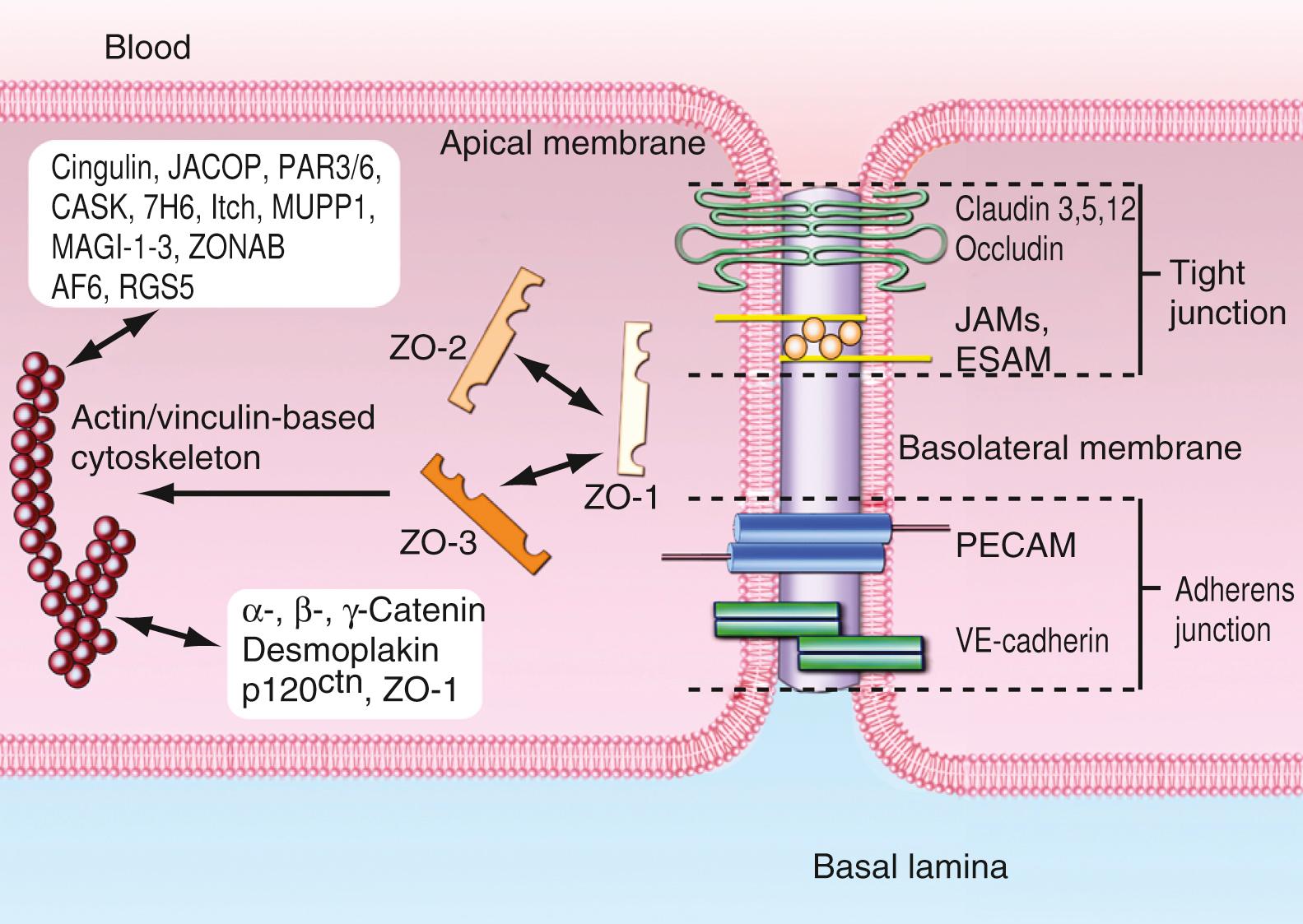
An interesting twist is the recent proposition that the gut microbiota influences BBB permeability through altered expression of claudin-5 and occludin. In these experiments, mice with a germ-free gut demonstrated greater BBB permeability than those with normal gut flora. These preliminary results, although intriguing, were obtained in rodents under tightly controlled experimental conditions; given the impact that diet has on the microbiome and the differences between human and rodent dietary patterns, the clinical relevance remains unknown.
This class of proteins forms multimers that anchor TJs to the cell membrane. There are three main adhesion proteins: zonula occludens-1 (ZO-1), ZO-2, and ZO-3. The first TJ-associated protein identified was ZO-1, a 220-kD membrane-associated protein expressed on both endothelial and epithelial cell surfaces. It serves as a scaffold for TJ formation by binding to the C-terminal of the cytoplasmic tail of occludin and the cytoskeletal protein spectrin. The importance of ZO-1 in TJ stability is illustrated by research showing that barrier integrity is compromised when ZO-1 expression is reduced or when ZO-1 is uncoupled from membrane proteins. While ZO-1 is expressed in both brain and peripheral ECs, there are distinct patterns of localization, with continuous expression in brain endothelium but discontinuous expression in peripheral ECs. ZO-2 is a 160-kD protein with regions homologous to ZO-1 that has been identified as a ZO-1–associated protein. In addition to its function at the TJ, ZO-2 is able to translocate to the nucleus, particularly during cell stress, where it appears to enhance proapoptotic signaling. Unlike ZO-1 and ZO-2, which are expressed by ECs, ZO-3 is seen solely in epithelial cells.
Occludin is a 65-kD transmembrane protein located at TJ margins , that is associated with cytoskeletal signaling proteins, including ZO-1 and ZO-2. Occludin is composed of four transmembrane domains with the terminal ends of the protein facing the cytoplasm, while two extracellular loops span the intracellular cleft. The transcript level and protein concentration of occludin in peripheral ECs is much lower than in brain ECs, where occludin localizes around cell-cell contacts. Occludin contains numerous phosphorylation sites, which are directly related to substance permeability. Occludin dysfunction is seen in numerous pathologic conditions, including HIV, cancer, and neuroinflammation. , Specifically, downregulation of 55-kD occludin expression is seen in high-grade (III and IV) brain tumors. Furthermore, conditions that promote activation of MMPs, such as ischemia, promote degradation of occludin and opening of the BBB.
Become a Clinical Tree membership for Full access and enjoy Unlimited articles
If you are a member. Log in here